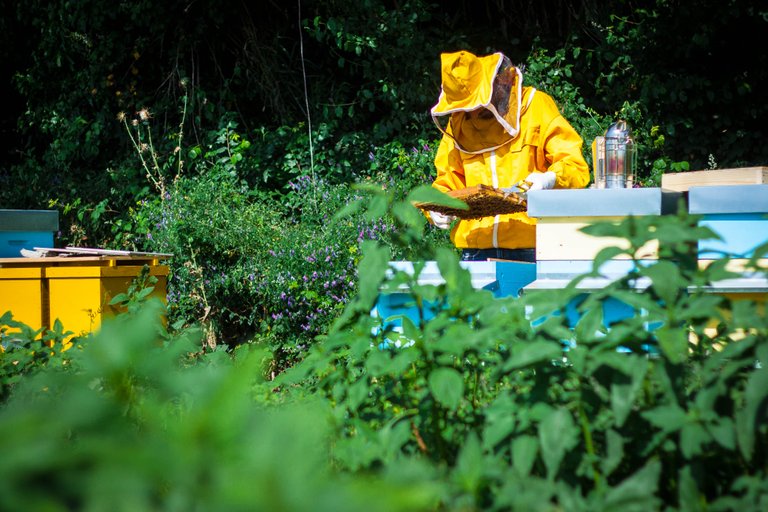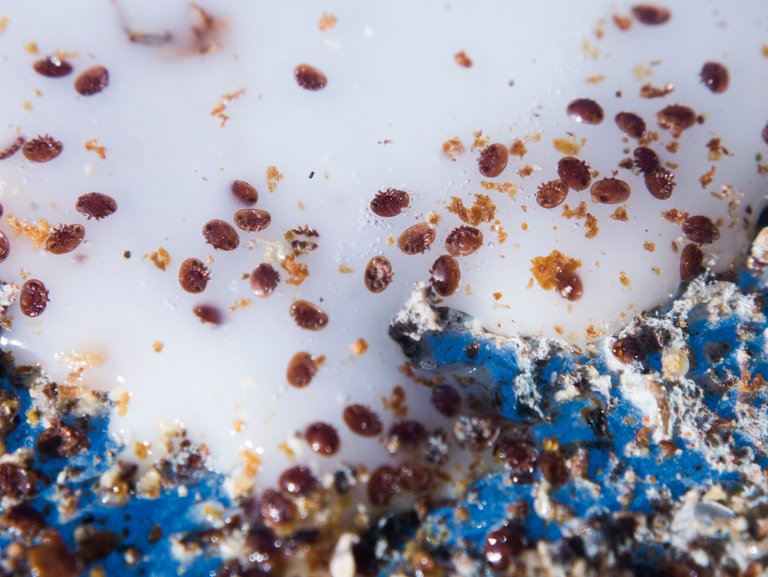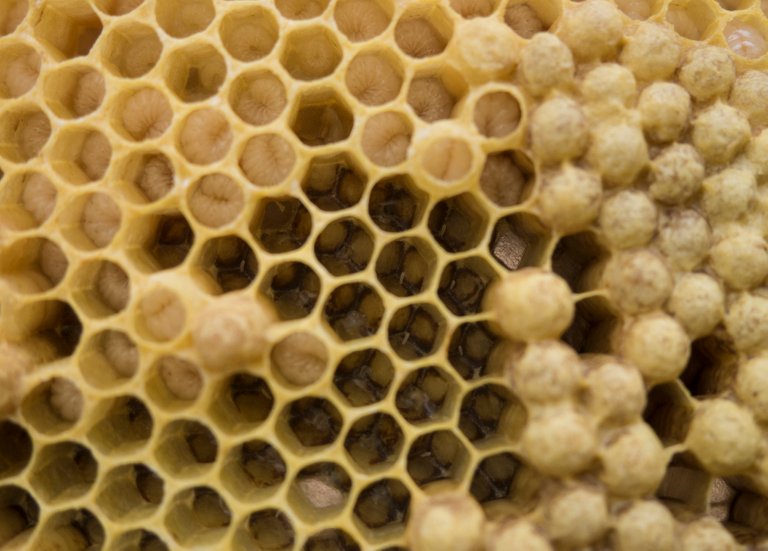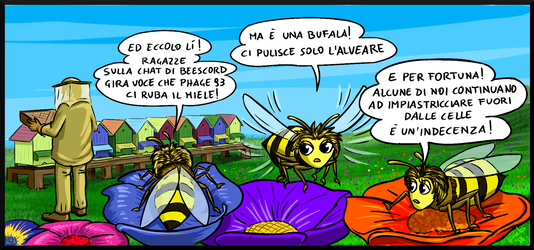Varroa, finalmente la soluzione? /Varroa, finally the solution?

Torniamo a parlare di varroa alla chiusura ormai della stagione 2019.
Resta il tema più discusso dagli apicoltori, ogni giorno nuove tecniche e nuovi principi attivi vengono sperimentati, molti dei quali senza alcun effetto, al punto che dopo più di trent'anni l'acido ossalico resta ancora uno tra i rimedi più efficaci in circolazione, ma che allo stesso tempo non debella radicalmente la varroa, e lascia all'apicoltore l’arduo compito di ripetere il trattamento ogni sei mesi, per cercare quantomeno, di tamponare il male.
Apprendevo in questi giorni di come la varroa in stato foretico, non attacchi le api principalmente per la loro linfa vitale, ma bensì per lo strato di grasso emesso dalle ghiandole dei tessuti adiposi.
Come viene riportato dai ricercatori dell'università dell'Illinois a Urbana-Champaign, Urbana, Illinois, all'interno della ricerca "Varroa destructor feeds primarily on honey bee fat body tissue and not hemolymph", la varroa predilige il grasso presente sulla peluria lasciando segni evidenti del suo passaggio sul corpo dell'ape.
Si evidenzia come effettivamente la varroa abbia un apparato boccale predisposto per una digestione extramandibolare, e quindi adatta alla consumazione di sostanze semi solide e non esclusivamente al fine di prelevare emolinfa. Un'altra nota a favore delle tesi deriva proprio dagli escrementi dell'acaro Varroa, che essendo in prevalenza composti da guanina lasciano pensare ad una dieta ricca di proteine.
We return to talk about varroa at the close of the 2019 season.
The subject remains the most discussed by beekeepers, new techniques and new active ingredients are being tested every day. Many of them have no effect, to the point that after more than thirty years oxalic acid remains one of the most effective remedies in circulation.
However it does not radically debug varroa, and leaves the beekeeper the arduous task of repeating the treatment every six months, to try at least to stem the evil.
I have learned these days how the varroa in a foretic state, does not attack the bees mainly for their vital sap, but rather for the layer of fat emitted by the glands of their fatty tissues.
As reported by researchers of the University of Illinois in Urbana-Champaign, Urbana, Illinois, within the research "varroa destructor feeds primarily on honey bee fat body tissue and hemolymph", varroa prefers the fat present on the hair leaving clear signs of its passage on bee body.
It is evident that actually the varroa has a buccal apparatus predisposed for an extra mandibular digestion, and therefore suitable for the consumption of semi-solid substances and not exclusively for the purpose of taking haemolymph. Another note in favor of the thesis derives from the excrements of the varroa mite, which being mainly composed of guanine suggest a high protein diet.

Varroa dopo il trattamento con acido ossalico.
Varroa after treatment with oxalic acid.
Da queste prime informazioni nasce la tesi dei ricercatori, ovvero che la Varroa non si alimenti in prevalenza di emolinfa, ma bensì del grasso corporeo dell’ape. In quest’ottica risulterebbero più chiare e congrue le varie informazioni che abbiamo a riguardo.
Quello che è stato fatto dal team in un primo momento, consiste nel mappare le posizioni dell’acaro che parassita l’ape ed evidenziare le zone maggiormente parassitate.
Si è visto come la disposizione degli acari, corrispondesse alle parti dell’ape con maggiore percentuali di tessuto adiposo (torace, addome e nel basso ventre).
Per capire meglio se ci fosse un nesso, tra la collocazione dei parassiti e la loro alimentazione, i ricercatori hanno somministrato alle api due tipi di marker diversi.
Il primo che mettesse in evidenza l’emolinfa, il secondo la parte grassa. Alimentando gli acari con api trattate in questa maniera è stato possibile evidenziare effettivamente quale fosse la loro dieta.
From this first information comes the thesis of the researchers, that the varroa is not fed mainly of hemolymph, but well of the body fat of the bee. In this context, the various information we have on the subject would be clearer and more appropriate.
What the team did at first is to map the positions of the mite that parasites the bee and highlight the most parasitic areas.
They observed how the disposition of the mites corresponded to the parts of the bee with greater percentages of adipose tissue (thorax, abdomen and in the lower abdomen).
To better understand if there was a link between the placement of parasites and their diet, the researchers gave the bees two different types of markers.
The first one to highlight the hemolymph, the second for the fat part. By feeding mites with bees treated in this way, it was possible to actually show what their diet was.

Dai primi risultati emersi si evince subito una prima correlazione per quanto riguarda il consumo della parte grassa. Ma oltre a questa prima analisi, si è passati ad un ulteriore prova di contrasto, per scongiurare la possibilità di alterazioni date dalle varie soluzioni utilizzate.
Anche in questo caso, le varroe alimentate esclusivamente con api trattate con Nile Red risultano positive durante la fase di contrasto.
Con queste prime due analisi è possibile già attribuire il grasso corporeo dell’ape alla dieta della varroa destructor.
Un ultimo test viene però portato avanti dal team di ricercatori, ovvero dimostrare se effettivamente una varroa alimentata con grasso corporeo possa vivere e riprodursi.
Per effettuare questa analisi, vari gruppi di varroe sono stati alimentati con percentuali diverse di grasso, che vanno dal 100% allo 0%. Allo stesso modo altri gruppi di varroe sono stati alimentati esclusivamente con emolinfa, seguendo lo stesso criterio tenuto per i gruppi precedenti.
Dai dati è emerso come "le larve alimentate esclusivamente con grasso" hanno un'aspettativa di vita più lunga. Con un tasso di fertilità molto più elevato rispetto alle varroe nutrite esclusivamente con emolinfina.
The first results show an initial correlation with the fat content consumption. In addition to this first analysis, we have moved on to a further test of contrast, to avoid the possibility of alterations given by the various solutions used.
Also in this case, varroa fed exclusively with Red Nile treated bees are positive during the contrast phase.
With these first two analyses it is already possible to attribute the bee’s body fat to the varroa destructor diet.
A final test, however, is carried out by the team of researchers. That is to show if actually a varroa fed with body fat could live and reproduce.
To perform this analysis, various groups of varroa have been fed with different percentages of fat, ranging from 100% to 0%. In the same way, other groups of varroa were fed exclusively with blood lymph, following the same criteria as for the previous groups.
From the data emerged as how the varroa fed with the fat part were able to reproduce more easily, and have a longer life expectancy. With a much higher fertility rate than varroa fed exclusively with haemolymph.

Covata maschile.
Male brood.
A questo punto però, mi viene da pensare che nello studio viene fatto riferimento alla percentuale di fertilità delle uova come parametro dimostrante di una maggiore % di riproduzione della varroa stessa.
Ma come sappiamo, l’acaro varroa è in grado di effettuare la partenogenesi, e quindi anche in assenza di esemplari maschi la varroa è in grado di riprodursi. Inoltre un altro aspetto importante che non viene menzionato tra i parametri presi in considerazione è la proporzione tra esemplari maschi e femmine che vengono presi per l’esperimento, e in che proporzione siano inseriti nei vari gruppi. Vengono citate soltanto le varroe di sesso femminile prese per parassitare le api.
Un ultimo dato secondo me molto importante, consiste nella fase dell’accoppiamento della varroa, che avviene all’interno delle celle appena opercolate, e non prima. Come presente in altri studi inoltre, viene preferita la covata maschile rispetto a quella femminile.
Viene riportato che effettivamente le situazioni del laboratorio non erano idonee per l’esperimento, ma se così fosse perché inserire i dati all'interno della ricerca?
Chiusa questa piccola parentesi di riflessione, speriamo che questa nuova scoperta possa portare un contributo per quella che è la lotta alla varroa.
At this point, however, I think that in the study the researcher made reference to the percentage of fertility of the eggs as a parameter demonstrating a higher percentage of reproduction of the varroa itself.
But as we know, the varroa mite is able to carry out the parthenogenesis, and therefore even in the absence of male specimens the varroa is able to reproduce. In addition, another important aspect that is not mentioned among the parameters taken into account is the proportion of males and females that are taken for the experiment, and in what proportion they are included in the various groups. Only female varroa taken to parasite bees are mentioned.
Last data in my opinion very important consists in the phase of the coupling of the varroa, that happens to the inside of the cells just opercolate, and not before. As in other studies, moreover, male brood is preferred over female brood.
The scientist reported that the laboratory situations were not suitable for the experiment, but if so why enter the data into the research?
Closed this small parenthesis of reflection, we hope that this new discovery can make a contribution to what is the fight against varroa.
Source
Varroa destructor feeds primarily on honey bee fat body tissue and not hemolymph
Reproduction of parasitic mites Varroa destructor in original and new honeybee hosts
Review of the orientation behaviour in the bee parasitic mite Varroa destructor: Sensory equipment and cell invasion behaviour
All photos are my property

Immagine di mia proprietà, realizzata da @pab.ink un ringraziamento speciale al team di @DaVinci.art
I have always wanted to go and take pictures of a bee keeper in action. Great shots.
If you come to Italy, i'll be happy to pose for you!
Deal
Hi, @phage93!
You just got a 14.92% upvote from SteemPlus!
To get higher upvotes, earn more SteemPlus Points (SPP). On your Steemit wallet, check your SPP balance and click on "How to earn SPP?" to find out all the ways to earn.
If you're not using SteemPlus yet, please check our last posts in here to see the many ways in which SteemPlus can improve your Steem experience on Steemit and Busy.
a me piace molto scrutare le api in ogni loro momento
Interesting, that this mite grows better on fat then protein. I would assume that protein promotes grow and fertility due to proteins are more anabolic than fat. Is there any theory about this metabolic paradoxon? Best Chapper
no that I know... I honestly found nothing, what they say is only based on their own assumptions...
Ok, thanks! Keep us informed when you found out more!
sure! thank you for had read my post!
This post has been voted on by the SteemSTEM curation team and voting trail. It is elligible for support from @curie and @minnowbooster.
If you appreciate the work we are doing, then consider supporting our witness @stem.witness. Additional witness support to the curie witness would be appreciated as well.
For additional information please join us on the SteemSTEM discord and to get to know the rest of the community!
Please consider using the steemstem.io app and/or including @steemstem in the list of beneficiaries of this post. This could yield a stronger support from SteemSTEM.